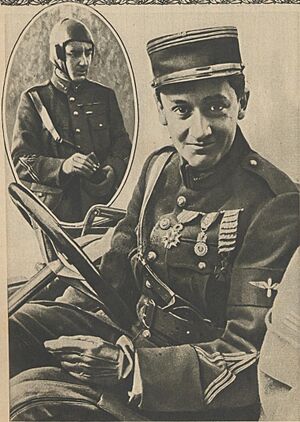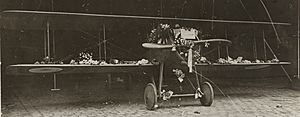Georges Guynemer facts for kids
Quick facts for kids
Georges Guynemer
|
|
|---|---|
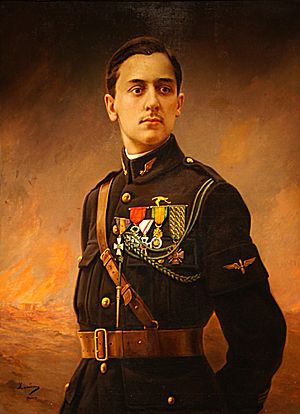
G. Guynemer by Lucien, Musée national de la Légion d'Honneur et des Ordres de Chevalerie
|
|
| Born | 24 December 1894 Paris, France |
| Died | 11 September 1917 (aged 22) South of Poelcappelle, Belgium (presumably) |
| Allegiance | |
| Service/ |
|
| Years of service | 1914–1917 |
| Rank | Capitaine |
| Unit | Escadrille N.3, MS 3, Spa3 |
| Awards | Légion d'honneur Croix de Guerre Médaille militaire Order of Karađorđe's Star |
Georges Guynemer (born December 24, 1894) was a famous French pilot during World War I. He was known for shooting down 54 enemy planes, making him the second-highest scoring French pilot. He became a national hero in France. Sadly, he went missing on September 11, 1917, and his death was a big shock to the country.
Contents
Georges Guynemer: A French Flying Ace
Early Life and Joining the Military
Georges Marie Ludovic Jules Guynemer was born in Paris, France. His family was wealthy and important. As a child, Georges was often sick and not very strong.
Because he was frail, he was turned down five times when he tried to join the military. But Georges was very determined! He finally got accepted to train as a mechanic in late 1914.
Becoming a Pilot
Georges didn't want to be just a mechanic. He worked hard and was accepted for pilot training. On June 8, 1915, he joined a flying unit called Escadrille MS.3. He stayed with this same unit for his entire time in the war.
His first plane was a Morane-Saulnier L monoplane. It was named Vieux Charles (which means Old Charles). Georges liked the name and kept it for most of his planes. On July 19, 1915, he shot down his first enemy plane, a German Aviatik.
Rising Through the Ranks
In December 1915, his unit got new Nieuport 10 fighter planes. The unit was renamed Escadrille N.3. With these better planes, Georges quickly became one of France's best fighter pilots.
He became an "ace" in February 1916, meaning he had shot down five enemy planes. He was promoted to lieutenant in March. By the end of 1916, he had shot down 25 planes! His commander called him "my most brilliant Stork." Less than a year later, Georges was promoted to captain and became the commander of the Storks squadron.
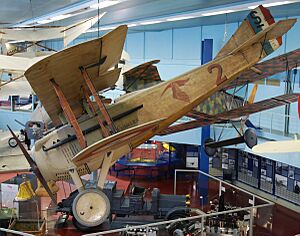
Helping Design New Planes
Georges Guynemer was so important that he even helped design new French fighter planes. In December 1916, he wrote a letter about the Spad VII plane. He said it wasn't as good as the German planes.
Because of his feedback, the company Spad developed two new models: the SPAD XII and SPAD XIII. These new planes were very promising.
His "Magic Plane"
On January 23, 1917, Georges shot down two enemy planes. On February 8, 1917, flying a SPAD VII, he became the first Allied pilot to shoot down a German Gotha bomber. This was his 31st victory!
His best month was May 1917, when he shot down seven German aircraft. By July, he started flying the Spad XII. He called it his avion magique (magic plane). This plane had a special 37 mm (1.46 in) cannon that fired through the propeller. It also had a machine gun.
The cannon was very powerful, but the plane was hard to fly. The pilot had to reload the cannon by hand in the air! It also had a strong kickback and filled the cockpit with smoke. Only a very skilled pilot like Guynemer could fly it. He used it to shoot down two more planes in July. This made him the first French ace to reach 50 victories! Newspapers celebrated with headlines like "Fifty machines destroyed! This had been Guynemer's dream!"
Georges Guynemer's Disappearance
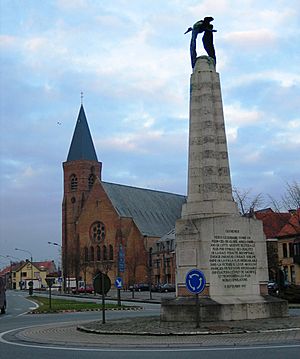
Georges Guynemer did not return from a combat mission on September 11, 1917. He had been having some mechanical problems with his planes that week. At 8:30 AM, he took off with a new pilot, Jean Bozon-Verduraz. Their mission was to patrol the Langemark area.
At 9:25 AM, near Poelkapelle, Georges saw a German observation plane and flew towards it. Bozon-Verduraz saw several enemy Fokker planes above him. By the time he got rid of them, Georges was gone. He never came back.
Georges Guynemer was officially declared missing in action by his commander. The French government announced it on September 25, 1917. Later, a captured German pilot and a German sergeant said they saw his plane crash. The sergeant said Georges died from a bullet to the head. However, the German soldiers could not recover his body because of Allied artillery fire.
At the time of his disappearance, Georges Guynemer had 54 victories.
His Lasting Legacy
Georges Guynemer became a huge national hero in France. The French government used his fame to help keep people's spirits up during the war. Georges was shy about all the attention, but this only made people want to know more about him.
He was only 22 when he disappeared, but he continued to inspire the nation. His famous advice was: "Until one has given all, one has given nothing."
Many things are named after him today. There is a street in Paris called rue Guynemer and a school in Compiègne called Institution Guynemer. A statue in Poelkapelle, Belgium, also honors him.
The TV show The Twilight Zone even had an episode called "The Last Flight" in 1960. It was loosely based on Georges Guynemer's disappearance.
Georges Guynemer received many awards, including the Order of Karađorđe's Star with swords.
|
See also
 In Spanish: Georges Guynemer para niños
In Spanish: Georges Guynemer para niños


